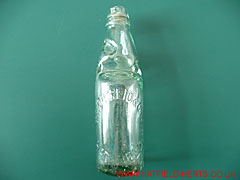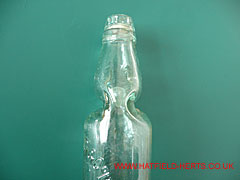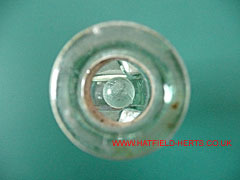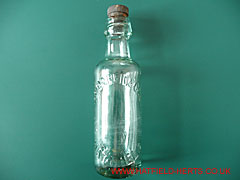Collectibles – Bottles (Part 2)
Cream Jugs
Literally used to store dairy cream. Originally stoneware but later glass.
Fire Extinguishers
These were early 'hand grenade' style extinguishers which contained a mix of chemicals which when exposed to air (by shattering the glass casing) would react and release a cloud of carbon dioxide which would smother a fire in a confined space by starving it of oxygen.
Inks
Long before the arrival of the ballpoint, Quills pens, made from the cut and shaped feathers of birds, were the commonest form of writing tool. They were later replaced by fountain pens which had their own ink reservoirs (later cartridges and other types of refills). Until ballpoint pens came into widespread use from the middle of the 20th Century people bought their ink in small bottles. Apart from the general branded ink bottle, wealthier individuals had elaborate inkstands that matched the lavishness of their homes (often a mix of glass and metal).
Medicines
Chemists or apothecaries, as they were more widely referred to in earlier years, used a wide range of glass bottles (again largely due to its resistant properties). Many, particularly in the Victorian era, were stamped with the maker's name and logo. There were also a large number of 'patent remedies' – rather dubious brews that were claimed to cure just about anything. This was, after all, the era of Caveat Emptor (Latin for 'Buyer beware'), before consumer protection laws were as strong as they are today.
Mineral Waters and Non-Alcoholic Drinks
Spa waters and non-alcoholic drink – like Ginger Beer – bottles also offer a wide range of collecting possibilities and are a possible option for people whose personal or religious beliefs mean they can't collect alcohol bottles. They come in a mix of stoneware and glass bottles (stoneware ginger beer bottles were in use up to 1930).
Making artificial mineral waters is credited to Joseph Priestly, an Englishman, in 1772 (although another source credits Jacob Schweppes in London in 1792).
Coca-Cola created in the 1880s by John Pemberton, an American chemist, was first advertised as having medicinal properties. Originally its two active ingredients were Coca leaves – the source of cocaine – and Kola nuts. Both packed significant amounts of caffeine. Sales were helped by The Prohibition – the banning of alcohol in some US states. The exact date Coca-Cola was first bottled isn't clear but it was certainly available in bottles by the 1890s. The prototype of the iconic 'hobbleskirt' bottle appeared in 1915.
Probably one of the most odd looking developments in bottle closure designs was the glass marble stopper developed by Hiram Codd of Camberwell in 1875. The seal was formed by an internal glass marble being pressed – by the gas in the brew – against a rubber ring in the neck. A wooden cap and plunger were used to push the marble down and trap it behind two lugs (depressions) in the neck of the bottle. There were several modifications to the Codd design – it is said largely to make the marble less attractive to young boys who would smash the empties to get at it – and Codd bottles are now something of a generic term for any bottle with the stopper in its neck. Codd bottles were in widespread use in Britain from 1875-1930.

6-inch (15cm) Codd bottle with rubber ring neck. Embossed "Pryor, Reid & Co Ltd, Hatfield"

Close up of the indentations in the neck of the Codd bottle

Glass marble visible inside the neck of a Codd bottle

8-inch (20cm) internal screw-top embossed (Pryor, Reid & Co Ltd, Hatfield) bottle. This bottle may have been used for Ginger beer or beer. The stopper does not bear the Pryor Reid name so it may not be the original (the shape of the bottle suggests the original was possibly a 'stone' stopper, the type which replaced the Codd marble stopper).
Miniatures
These are generally smaller versions of spirit bottles. Their smaller size making them more appropriate to display and store for people who don't have a lot of space.
Perfumes
In terms of shape and form these are probably the most elaborate and exquisite forms of bottles. Many old perfume bottles featured human forms (often female) and are called figurals. Even today, perfume bottles are probably the most elaborate and complex bottles produced in large quantities.
Poisons
Like with medicines, the chemical and heat resistant properties of glass made it the ideal material to store them in. However, apart from the word 'Poison' being stamped or embossed on the bottle, they were often marked out by their deep blue colour. This was obtained by adding cobalt to the mix of molten glass.
Spirits
Most spirits are sold in glass bottles. In the 17th Century, Gin was the drink of choice for poorer folk and was imported in huge quantities from the Netherlands. Bottles were shipped in cases of 12 bottles. To make the best use of the available space, bottles, which were hand-blown, were made into a square shape by blowing the molten glass inside a wooden mould. These were known as Case bottles, and even today many brands of Gin are still sold in square bottles.
Wine
Wine was the first major beverage to be sold in glass bottles – the first appeared around the 1650s. These were first sealed with oiled hemp but were soon replaced by cork wedges. However, the bottles used were mainly the property of wealthy buyers who used to sent them to the wine merchants to fill them from their barrels. Often these would bear the owners name or coat of arms (it was only around a 100 years later that merchants adopt the idea of putting their own seal on bottles and selling wine).
Back to: Hobbies and Collections